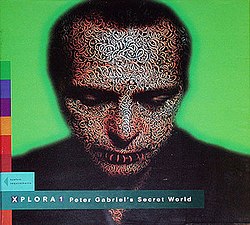Summary
XPLORA1 was conceived by Brilliant Media's Steve Nelson and pitched to Peter in 1990. The project was developed at Brilliant Media's offices in SOMA, San Francisco, CA. The design and coding for the initial release on Mac CDROM was created in HyperCard. Footage was filmed at WOMAD and on location at the studio in Bath, UK. The branding, marketing and retail distribution was handled by Brian Fargo 's Interplay Studios. [1] It was first released for Macintosh in 1993, followed by Windows in 1994 and CD-i in 1995, in which the project was completed in collaboration with Brilliant Media under Gabriel's own label Real World Records. [2]
The gameplay consists of a number of sub-games such as scavenger hunts, sliding mixes, music, and puzzles. [3] The game offers an interactive mode and a watch mode. In interactive mode, the player can explore brief summaries of a number of musicians Gabriel has performed with in the past. [4] One feature allows the player to create custom remixes using guitars, drums, and Gabriel's voice. [5] Watch mode provides a synopsis of Gabriel's music without the player-input found in interactive mode. [6] As the player completes puzzles and accomplishes goals, new areas of the CD are unlocked that feature new content for the player to explore. [4] The game features footage from Gabriel's childhood, including various baby pictures. [1] [5] It comprises over 140 minutes of visuals and audio, including the full-length tracks of "Digging in the Dirt" and "Steam". [7] [8] In the UK, the game was exclusively sold at 49 HMV retail stores. [9]
Reception
Computer Gaming World said in March 1994 that while the backstage footage was interesting, "explorers will have the most fun remixing their own Peter Gabriel music videos and joining in on jam sessions. Multimedia is a much abused term, but this beautiful work deserves the title". [10] William Casey of The Seattle Times found the game to be "innovative" but found that the overall experience was "somewhat bumpy and unpredictable". [5]
Xplora1 received three awards from the Academy of Interactive Arts & Sciences [11] for:
- Best Interactive Product of 1994,
- Best Musical, and
- Best use of Music
The game sold more than 100,000 copies globally and more than 2,000 copies in Australia. [12]
This page is based on this
Wikipedia article Text is available under the
CC BY-SA 4.0 license; additional terms may apply.
Images, videos and audio are available under their respective licenses.
